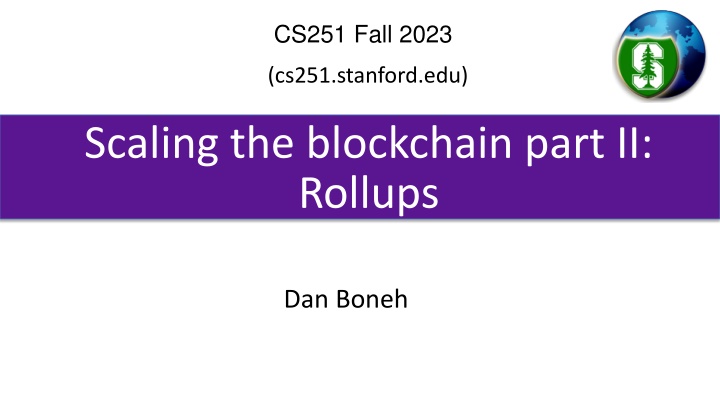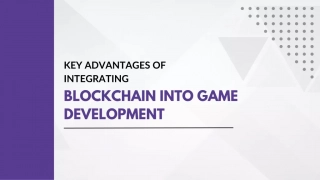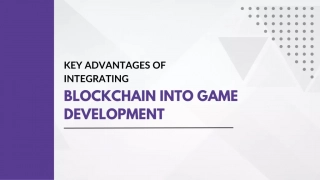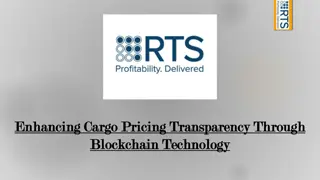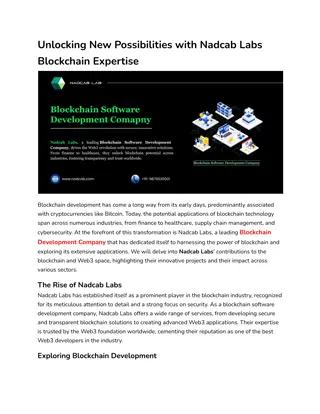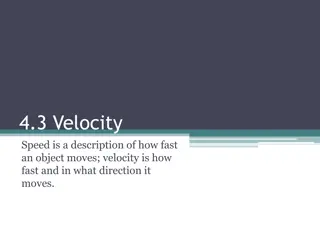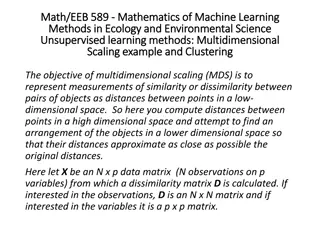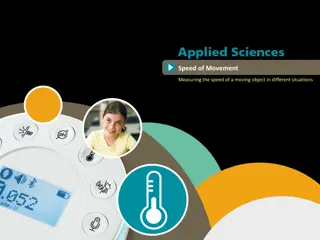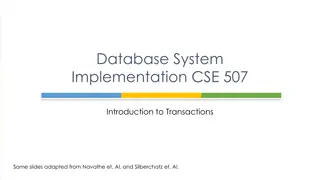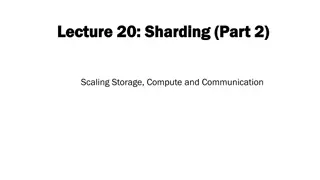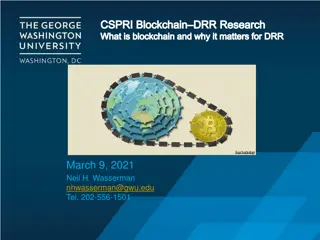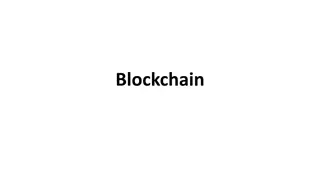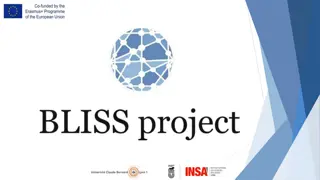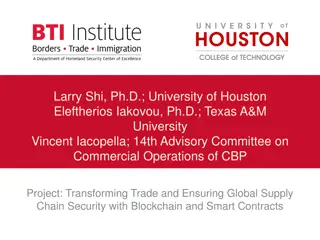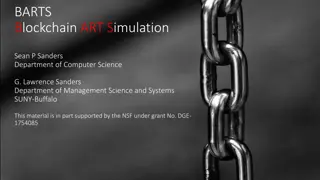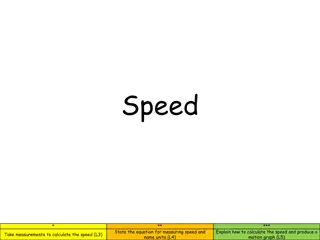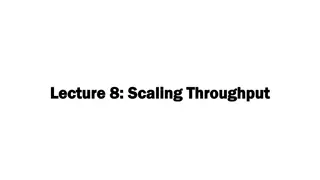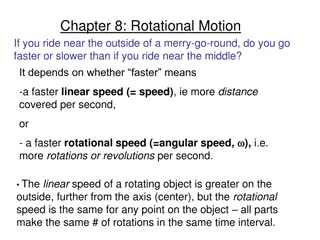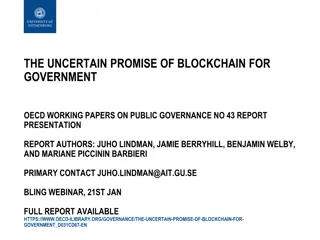Scaling the Blockchain: Rollups for Increased Transaction Speed
Exploring the challenges of scaling blockchain networks to match the transaction speeds of traditional payment networks like Visa. Solutions such as Rollups, batch processing, and payment channels are discussed to increase transaction throughput while maintaining low fees.
Download Presentation

Please find below an Image/Link to download the presentation.
The content on the website is provided AS IS for your information and personal use only. It may not be sold, licensed, or shared on other websites without obtaining consent from the author.If you encounter any issues during the download, it is possible that the publisher has removed the file from their server.
You are allowed to download the files provided on this website for personal or commercial use, subject to the condition that they are used lawfully. All files are the property of their respective owners.
The content on the website is provided AS IS for your information and personal use only. It may not be sold, licensed, or shared on other websites without obtaining consent from the author.
E N D
Presentation Transcript
CS251 Fall 2023 (cs251.stanford.edu) Scaling the blockchain part II: Rollups Dan Boneh
Scaling the blockchain: the problem Transaction rates (Tx/sec): Bitcoin: can process about 7 (Tx/sec) Tx Fees fluctuate: 2$ to 60$ for simple Tx Ethereum: can process about 15 (Tx/sec) The visa network: can process up to 24,000 (Tx/sec) Can we scale blockchains to visa speeds? with low Tx fees
How to process more Tx per second Many ideas: reduces composability Use a faster consensus protocol Parallelize: split the chain into independent shards Today: Rollups, move the work somewhere else Payment channels: reduce the need to touch the chain Requires locking up funds; mostly designed for payments.
Recall: a basic layer-1 blockchain A layer-1 blockchain (e.g., Ethereum) Can handle 15 Tx/sec current world state TxA updated world state TxB updated world state World state: balances, storage, etc.
Rollup idea 1: batch many Tx into one A layer-1 blockchain (e.g., Ethereum) updated Rollup state root, and Tx list Rollup coordinator current world state (Rollup state Merkle root) TxB (Tx list) updated world state (updated Rollup state root) Rollup state: Alice s balance Bob s balance
Rollup idea 1: batch many Tx into one A layer-1 blockchain (e.g., Ethereum) Key point: Hundreds of transactions on Rollup state are batched into a single transaction on layer-1 current world state (Rollup state Merkle root) 100x speed up in Tx/sec (Tx list) updated world state (updated Rollup state root) Rollup state: Alice s balance Bob s balance Let s see how
Rollup operation (simplified) Rollup coordinator [A B: 2 ETH], ???? Layer 1 blockchain (e.g. Ethereum) atomic swap: [B Z: 1 ETH] [Z B: 2 USDC] ???? ???? Rollup state root block 354 Merkle Tree Alice: 5 DAI 3 ETH Bob: 2 ETH Zoe: 1 ETH 3 USDC Tx
Rollup operation (simplified) Rollup coordinator [A B: 2 ETH], ???? Layer 1 blockchain (e.g. Ethereum) atomic swap: [B Z: 1 ETH] [Z B: 2 USDC] ???? ???? new Rollup root block 354 block 361 Merkle Tree Alice: 5 DAI 1 ETH Bob: 3 ETH 2 USDC Zoe: 2 ETH 1 USDC Tx
In more detail Rollup state (L2) Rollup contract on layer-1 holds assets of all Rollup accounts (and Merkle state root) Alice: 4 ETH, 1 DAI Bob: 3 ETH, 2 DAI (coordinator stores state) Rollup contract: 7 ETH, 3 DAI, Alice: state Bob: state Uniswap: state root Layer-1 blockchain (L1)
Transfers inside Rollup are easy (L2 L2) Rollup state (L2) Alice: 4 ETH, 1 DAI Bob: 3 ETH, 2 DAI [A B: 2 ETH], ???? (with hundreds of Tx) Rollup contract: 7 ETH, 3 DAI, Alice: state Bob: state Uniswap: state root Layer-1 blockchain (L1)
Transfers inside Rollup are easy (L2 L2) Coordinator updates root on Rollup contract Rollup state (L2) Alice: 2 ETH, 1 DAI Bob: 5 ETH, 2 DAI [A B: 2 ETH], ???? (with hundreds of Tx) new Merkle root, Tx list Rollup contract: 7 ETH, 3 DAI, Alice: state Bob: state Uniswap: state root Layer-1 blockchain (L1)
Transferring funds into Rollup (L1 L2) Alice issues an L1 Tx: slow and expensive Rollup state (L2) Alice: 2 ETH, 1 DAI Bob: 5 ETH, 2 DAI Rollup contract: 7 ETH, 3 DAI, Alice: state Bob: state Uniswap: state root 2 ETH Layer-1 blockchain (L1)
Transferring funds into Rollup (L1 L2) Alice issues an L1 Tx: slow and expensive Rollup state (L2) Alice: 4 ETH, 1 DAI Bob: 5 ETH, 2 DAI new Merkle root, Tx list Rollup contract: 9 ETH, 3 DAI, Alice: state Bob: state Uniswap: state root 2 ETH Layer-1 blockchain (L1)
Transferring funds out of Rollup (L2 L1) Requires extra gas on L1 to process transfer Rollup state Alice: 4 ETH, 1 DAI Bob: 5 ETH, 2 DAI [withdraw 4 ETH], ???? (plus hundreds of Tx) Rollup contract: 9 ETH, 3 DAI, Alice: state Bob: state Uniswap: state root Layer-1 blockchain (L1)
Transferring funds out of Rollup (L2 L1) Requires extra gas on L1 to process transfer Rollup state Alice: 0 ETH, 1 DAI Bob: 5 ETH, 2 DAI [withdraw 4 ETH], ???? (plus hundreds of Tx) new Merkle root, Tx list Rollup contract: 5 ETH, 3 DAI, Alice: state Bob: state Uniswap: state root 4 ETH Layer-1 blockchain (L1)
Summary: transferring Rollup assets Transactions within a Rollup are easy: Batch settlement on L1 network (e.g., Ethereum) Moving funds into or out of Rollup system (L1 L2) is expensive: Requires posting more data on L1 network higher Tx fees. Moving funds from one Rollup system to another (L2 L2) Either via L1 network (expensive), or via a direct L2 L2 bridge (cheap)
Running contracts on a Rollup? Two copies of Uniswap Rollup state (L2) Alice: 4 ETH, 1 DAI Bob: 3 ETH, 2 DAI Rollup users can cheaply interact with Uniswap on Rollup Uniswap: Rollup contract: 7 ETH, 3 DAI, Alice: state Bob: state Uniswap: state state root Layer-1 blockchain (L1)
Running contracts on a Rollup? Rollup state (L2) Uniswap: state Alice: 4 ETH, 1 DAI Bob: 3 ETH, 2 DAI Coordinator maintains state of all contracts on Rollup system: It updates the Uniswap Merkle leaf after every Tx to Uniswap Writes updated Rollup state Merkle root to L1 chain
Running contracts on a Rollup? Rollup state (L2) Uniswap: state Alice: 4 ETH, 1 DAI Bob: 3 ETH, 2 DAI Rollup functions as Ethereum, but It relies on the L1 chain to attest to the current Rollup state
How to send Tx to the coordinator Enduser configures its wallet to send Tx to the RPC points of the selected Rollup. (by default Metamask sends Tx to the Ethereum Mainnet RPC points)
The role of the Coordinator The Coordinator has multiple tasks: Sequence incoming Tx from Rollup users into a stream of Tx can extract MEV from searchers, in addition to Tx fees very profitable to be a Rollup coordinator Execute the stream of Tx on the latest Rollup state Push updates to the L1 chain Shared coordinator: one coordinator for multiple Rollups (not today)
Coordinator architectures A centralized coordinator: availability and censorship concerns, but cannot steal assets (as we will see) A decentralized coordinator: a set of parties that run a fast consensus protocol At every epoch one party is chosen to sequence, execute, and push updates to the L1 Importantly: L1 provides ground truth of the Rollup state
Tx rate on L2 is higher than on L1 L2 block L2 chain L1 chain Finalize on L1 Finalize on L1
An example (StarkNet -- using validity proofs) Block Tx posted on L1 (Ethereum) about every eight hours Source: starkscan.co
Problems Problem 1: what if coordinator is dishonest? It could steal funds from the Rollup contract It could issue fake Tx on behalf of users Problem 2: what if coordinator stops providing service? If Rollup state is lost, how can users issue Tx? can t compute updated Rollup Merkle root.
Problem 1: what if coordinator is dishonest? Can coordinator steal funds from Rollup users? No! L1 chain verifies that Rollup state updates are valid. all Tx are valid and properly signed by the Rollup users Challenge: how to do this cheaply ?? (with little gas on L1) Rollup contract: 7 ETH, 3 DAI, root Alice: state Bob: state Layer-1 blockchain (L1)
Verifying Rollup state updates Approach 1: validity proofs (called a zk-Rollup) Succinct proof proves that a batch of hundreds of Tx is valid Layer 1 blockchain (e.g. Ethereum) Rollup coordinator TxA Rollup contract TxB accept new root only if valid proof Tx list
What the SNARK proof proves SNARK proof is short and fast to verify: Cheap to verify proof on the slow L1 chain (with EVM support) (usually not a zero knowledge proof) Public statement: (old state root, new state root, Tx list) Witness: (state of each touched account pre- and post- batch, Merkle proofs for touched accounts, user sigs) SNARK proof proves that: (1) all user sigs on Tx are valid, (2) all Merkle proofs are valid, (3) post-state is the result of applying Tx list to pre-state
zkEVM When a contract (e.g. Uniswap) runs on a Rollup: coordinator builds a SNARK proof of correct execution of an EVM program called a zkEVM Generating proof is a heavyweight computation verifying proof is fast Rollup coordinator Flavors of a zkEVM: Prove that EVM bytecode ran correctly (Polygon zkEVM, Scroll) Compile Solidity to a SNARK-friendly circuit (MatterLabs) (lots of GPUs)
The end result Rollup contract on L1 ensures coordinator cannot cheat: all submitted Tx must have been properly signed by users all state updates are valid Rollup contract on L1 will accept any update with a valid proof Anyone can act as a coordinator (with enough compute power)
Verifying Rollup state updates Approach 2: fault proofs (called an optimistic Rollup) Coordinator deposits stake in escrow on L1 Rollup contract Operation: Coordinator submits state updates to L1 w/o a proof If update is invalid: anyone has seven days to submit a fault proof Successful fault proof means coordinator gets slashed on L1 Unsuccessful fault proof costs complainer a fee Challenge: how to prove a fault to the Rollup contract on L1 ?? Naively: L1 can re-execute all Tx in batch expensive and slow
Fault Proof game pre-root Tx list fault claim coordinator Coordinator computes Merkle tree of all states. Sends Merkle root to L1 different post-root claimed post-root pre- state post- state break computation into small steps
Fault Proof game pre-root Tx list we know ?????? ?????? fault claim coordinator Merkle root different ?????? claimed ?????? hash[0 n/2] hash[n/2 n] hash[n/4 n/2] hash[0 n/4] ??????/2 ?????? ?????0
Fault Proof game: binary search pre-root Tx list Suppose??????/2 ??????/2 fault claim coordinator Merkle root different ?????? claimed ?????? hash[0 n/2] hash[n/2 n] hash[n/4 n/2] hash[0 n/4] ??????/2 ?????? ?????0
Fault Proof game: binary search pre-root Tx list Suppose??????/2 ??????/2 fault claim coordinator Merkle root different ?????? claimed ?????? hash[0 n/2] hash[n/2 n] hash[n/4 n/2] hash[0 n/4] Coordinator sends hash[0 n/2]to L1 Alice sends left to L1 ??????/2 ?????0
Fault Proof game: binary search pre-root Tx list Suppose??????/4= ??????/4 fault claim coordinator Merkle root different ?????? claimed ?????? hash[0 n/2] hash[n/2 n] hash[n/4 n/2] hash[0 n/4] Coordinator sends hash[n/4 n/2] to L1 Alice sends right to L1 ??????/2 ??????/4 ?????0
Fault Proof game: binary search pre-root Tx list Suppose??????/4= ??????/4 fault claim coordinator Merkle root different ?????? claimed ?????? hash[0 n/2] hash[n/2 n] hash[n/4 n/2] hash[0 n/4] Coordinator sends hash[n/4 n/2] to L1 Alice sends right to L1 ??????/2 ??????/4
Fault Proof game: binary search pre-root Tx list coordinator After log2? rounds: L1 has ?????? and ??????+1 from coordinator ?????? = ?????? and ??????+1 ??????+1 or game times out because one player defects Now L1 can verify fault proof by checking one computation step!
A simpler alternative pre-root Tx list different ?????? claimed ?????? Alice submits to L1 contract a SNARK proof that ?????? is invalid L1 verifies SNARK, and if valid, slashes coordinator SNARK is only needed in a rare fault event
Some difficulties with optimistic approach (1) Transactions only settle after 7 days (after fault window expires) Alice needs to wait 7 days to withdraw funds from Rollup (Rollup contract will only send her the funds after 7 days) For fungible tokens, a 3rd party can advance the funds to Alice after checking validity of Alice s withdraw Tx. Does not apply to non-fungible tokens. (2) Suppose a successful fault proof 4 days after batch is posted all subsequent Tx need to be reprocessed
The end result Can easily port any smart contract to an optimistic Rollup The Rollup EVM can be enhanced with new features (opcodes) High Tx throughput: in principle, up to 4000 tx/s No need for special hardware at the coordinator Anyone can act as a coordinator and a verifier Downside: 7 day finality delay
ok, so coordinator cannot submit invalid Tx. Problem 2: centralized coordinator, what if it stops providing service? Solution: setup a new coordinator but need the latest Rollup state Where to get state?? The data availability problem
Ensuring Rollup state is always available The definition of a Rollup: Rollup state can always be reconstructed from data on the L1 chain Layer 1 blockchain (e.g. Ethereum) coordinator Tx list Rollup contract state root Sent to Rollup contract on L1 as part of state update message
Ensuring Rollup state is always available To reconstruct current Rollup state: Read all Rollup update messages and re-execute Tx. anyone can become a coordinator Rollups use L1 for data storage What to store? For zk-Rollup: send Tx summary to L1, without user signatures (SNARK proof proves validity of signatures) For optimistic: need to send Tx summary *and* signatures to L1
Ensuring Rollup state is always available The downside: expensive Tx list is sent as calldata: 16 gas per non-zero byte (EIP-4844: store Tx list as a cheap blob) Can we do better?
Data Availability Committee (DAC) To further reduce Tx fees: Store L2 state root (small) on the L1 chain Store Tx data (large) with a Data Availability Committee (DAC): a set of nodes trusted to keep the data available cheaper than storage on L1 L1 accepts an update only if all DAC members sign it ensures that all DAC members accepted Tx data Setting up a new coordinator depends on availability of the DAC
Validium Validium: an L2 using a DAC and validity proofs (SNARKs) Well suited for lower value assets. Potential privacy benefits only DAC members see Tx data An example: StarkEx uses a five member DAC Users can choose between Validium or Rollup modes (Tx data off-L1-chain vs. Tx data on-L1-chain) cheaper Tx fees, but only secure as DAC More expensive Tx, but same as L1 security
Summary: types of L2 Scaling the blockchain: Payment channels and Rollups (L2 scaling) SNARK security Fraud proofs validity proofs Tx data on L1 chain optimistic Rollup, 7 day finality zkRollup availability Validium (reduced fees, but higher risk) Tx data in a DAC Plasma
Volume of some L2 systems Tx Volume/day average fee/tx (on Nov. 27, 2023) Ethereum: 1077K Tx 7.8 USD/Tx Arbitrum: 676K Tx 0.30 USD/Tx (optimistic Rollup) Optimism: 284K Tx 0.26 USD/Tx (optimistic Rollup) StarkNet: 537K Tx 0.56 USD/Tx (zkRollup)
